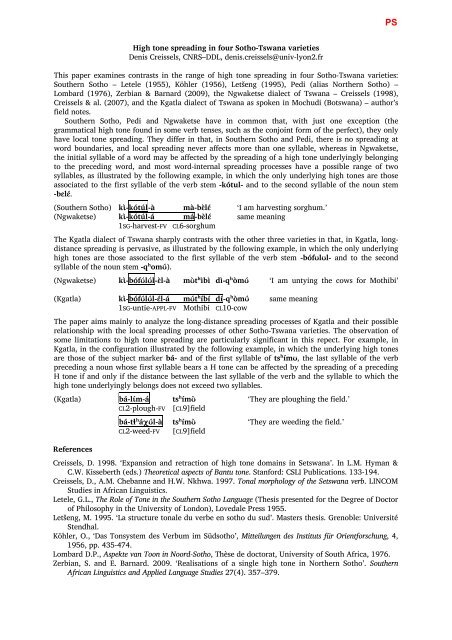here - 5th International Conference on Bantu Languages
here - 5th International Conference on Bantu Languages
here - 5th International Conference on Bantu Languages
Create successful ePaper yourself
Turn your PDF publications into a flip-book with our unique Google optimized e-Paper software.
High t<strong>on</strong>e spreading in four Sotho-Tswana varieties<br />
Denis Creissels, CNRS–DDL, denis.creissels@univ-ly<strong>on</strong>2.fr<br />
This paper examines c<strong>on</strong>trasts in the range of high t<strong>on</strong>e spreading in four Sotho-Tswana varieties:<br />
Southern Sotho – Letele (1955), Köhler (1956), Letšeng (1995), Pedi (alias Northern Sotho) –<br />
Lombard (1976), Zerbian & Barnard (2009), the Ngwaketse dialect of Tswana – Creissels (1998),<br />
Creissels & al. (2007), and the Kgatla dialect of Tswana as spoken in Mochudi (Botswana) – author’s<br />
field notes.<br />
Southern Sotho, Pedi and Ngwaketse have in comm<strong>on</strong> that, with just <strong>on</strong>e excepti<strong>on</strong> (the<br />
grammatical high t<strong>on</strong>e found in some verb tenses, such as the c<strong>on</strong>joint form of the perfect), they <strong>on</strong>ly<br />
have local t<strong>on</strong>e spreading. They differ in that, in Southern Sotho and Pedi, t<str<strong>on</strong>g>here</str<strong>on</strong>g> is no spreading at<br />
word boundaries, and local spreading never affects more than <strong>on</strong>e syllable, w<str<strong>on</strong>g>here</str<strong>on</strong>g>as in Ngwaketse,<br />
the initial syllable of a word may be affected by the spreading of a high t<strong>on</strong>e underlyingly bel<strong>on</strong>ging<br />
to the preceding word, and most word-internal spreading processes have a possible range of two<br />
syllables, as illustrated by the following example, in which the <strong>on</strong>ly underlying high t<strong>on</strong>es are those<br />
associated to the first syllable of the verb stem -kótul- and to the sec<strong>on</strong>d syllable of the noun stem<br />
-bɛlɛ́.<br />
(Southern Sotho) kɩ̀-kótúl-à mà-bɛ̀lɛ́ ‘I am harvesting sorghum.’<br />
(Ngwaketse) kɩ̀-kótúl-á má-bɛ̀lɛ́ same meaning<br />
1SG-harvest-FV CL6-sorghum<br />
The Kgatla dialect of Tswana sharply c<strong>on</strong>trasts with the other three varieties in that, in Kgatla, l<strong>on</strong>gdistance<br />
spreading is pervasive, as illustrated by the following example, in which the <strong>on</strong>ly underlying<br />
high t<strong>on</strong>es are those associated to the first syllable of the verb stem -bófʊlʊl- and to the sec<strong>on</strong>d<br />
syllable of the noun stem -qʰomʊ́).<br />
(Ngwaketse) kɩ̀-bófʊ́lʊ́l-ɛ̀l-à mʊ̀tʰìbì dì-qʰòmʊ́ ‘I am untying the cows for Mothibi’<br />
(Kgatla) kɩ̀-bófʊ́lʊ́l-ɛ́l-á mʊ́tʰíbí dí-qʰòmʊ́ same meaning<br />
1SG-untie-APPL-FV Mothibi CL10-cow<br />
The paper aims mainly to analyze the l<strong>on</strong>g-distance spreading processes of Kgatla and their possible<br />
relati<strong>on</strong>ship with the local spreading processes of other Sotho-Tswana varieties. The observati<strong>on</strong> of<br />
some limitati<strong>on</strong>s to high t<strong>on</strong>e spreading are particularly significant in this repect. For example, in<br />
Kgatla, in the c<strong>on</strong>figurati<strong>on</strong> illustrated by the following example, in which the underlying high t<strong>on</strong>es<br />
are those of the subject marker bá- and of the first syllable of tsʰímʊ, the last syllable of the verb<br />
preceding a noun whose first syllable bears a H t<strong>on</strong>e can be affected by the spreading of a preceding<br />
H t<strong>on</strong>e if and <strong>on</strong>ly if the distance between the last syllable of the verb and the syllable to which the<br />
high t<strong>on</strong>e underlyingly bel<strong>on</strong>gs does not exceed two syllables.<br />
(Kgatla) bá-lɩ́m-á tsʰímʊ̀ ‘They are ploughing the field.’<br />
CL2-plough-FV [CL9]field<br />
References<br />
bá-tɬʰáχʊ́l-à tsʰímʊ̀ ‘They are weeding the field.’<br />
CL2-weed-FV [CL9]field<br />
Creissels, D. 1998. ‘Expansi<strong>on</strong> and retracti<strong>on</strong> of high t<strong>on</strong>e domains in Setswana’. In L.M. Hyman &<br />
C.W. Kisseberth (eds.) Theoretical aspects of <strong>Bantu</strong> t<strong>on</strong>e. Stanford: CSLI Publicati<strong>on</strong>s. 133-194.<br />
Creissels, D., A.M. Chebanne and H.W. Nkhwa. 1997. T<strong>on</strong>al morphology of the Setswana verb. LINCOM<br />
Studies in African Linguistics.<br />
Letele, G.L., The Role of T<strong>on</strong>e in the Southern Sotho Language (Thesis presented for the Degree of Doctor<br />
of Philosophy in the University of L<strong>on</strong>d<strong>on</strong>), Lovedale Press 1955.<br />
Letšeng, M. 1995. ‘La structure t<strong>on</strong>ale du verbe en sotho du sud’. Masters thesis. Grenoble: Université<br />
Stendhal.<br />
Köhler, O., ‘Das T<strong>on</strong>system des Verbum im Südsotho’, Mitteilungen des Instituts für Orientforschung, 4,<br />
1956, pp. 435-474.<br />
Lombard D.P., Aspekte van To<strong>on</strong> in Noord-Sotho, Thèse de doctorat, University of South Africa, 1976.<br />
Zerbian, S. and E. Barnard. 2009. ‘Realisati<strong>on</strong>s of a single high t<strong>on</strong>e in Northern Sotho’. Southern<br />
African Linguistics and Applied Language Studies 27(4). 357–379.<br />
PS


